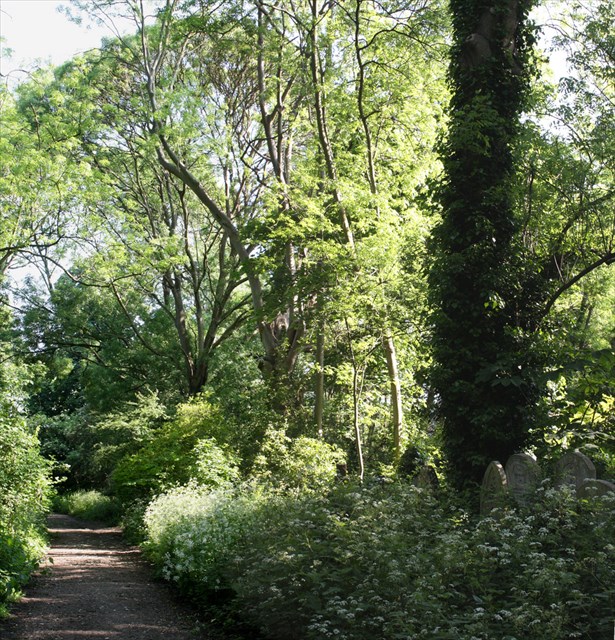Abney Park #1: Arboreal Paradise

The cache, a small screw-topped plastic camo-pot is hidden in the far (north-eastern) corner of Abney Park Cemetery Nature Reserve - a 32 acre historic, atmospheric, botanical paradise and earthly resting place for over 200,000 departed.
For extensive background information on the Park see lauralai's GC4XGPP Deep Dark Wood cache.
Permission to place the cache was kindly granted by the Parks Development Officer, Leisure & Green Spaces, Hackney Council.
The first impression on entering Abney Park is of trees - and lots of them! It is Hackney's only mature woodland - originally a wooded area sloping down from an ancient ridgeway track in the south (now Church Street) to Hackney Brook in the north, which was diverted underground in Victorian times.
In 1840, the parkland became a non-conformist and non-denominational garden cemetery which contained up to 2,500 named varieties of tree making it the largest tree collection after Loddiges' Nursery in Hackney which supplied most of the trees (see http://www.biodiversitylibrary.org/bibliography/68505# - copy & paste the link into your browser - for their 1820 catalogue).
Several rare and old 'heritage' trees survive and many are worthy of note. There are around 200 'old' trees - big, old trees are vital for providing homes for bats, owls and other animals, also many insects and fungi can only exist where there are old trees at just the right stage of decay. Hybridisation ('cross-breeding') adds a fascinating dimension to the range of trees in the Park.
The Abney Park Veteran Tree Project funded by the London Tree and Woodland Grant Scheme was created in 2009 in recognition of the importance of the old trees. A veteran tree is a one with particular value to wildlife due to damage, decay or old age. Many small mammals, birds, invertebrates and fungi rely on veteran trees for food or shelter. Some species can only live on old, dead or dying trees which is why veteran trees are so important for biodiversity.
During 2009 over 170 old trees were surveyed and 60 were found to have veteran characteristics. 30 of the more vulnerable veterans were chosen for the project. Many of the trees were in urgent need of work to stop them falling apart or being shaded out by vigorous young ash. A specialised tree gang was trained in veteran tree management techniques and set about this vital task. In particular the poplars, now over 120 years old, needed to be re-pollarded to stop them splitting apart. The project has been a great success and many trees have been given a new lease of life thanks to pollarding or halo pruning. See the Gallery for a location map of the veteran trees in the Reserve.
Some of the main species present in the Park are:
Oak (Quercus) - apart from English Oak there are 11 distinct species + numerous self-seeding hybrids. Lucombe Oak, a Turkey/Cork Oak hybrid is an Abney speciality
Thorn (Crataegus) - one hawthorn is thought to be over 200 years old, probably Hackney's oldest tree, and a relic of the old parkland. Various-leaved hawthorn has naturalised from the original plantings and is nationally important
Elm (Ulmus) - a fine avenue of elms grew along Great Elm Walk but these were felled as a result of Dutch Elm disease in the 1970s. Suckers till grow from old rootstock and may reach 6m before dying off.
Pine (Pinus) - heritage species include Bhutan and Corsican pines. At least one another has defied identification and has been dubbed Pinus mysterious!
Chestnut (Aesculus) - one magnificent old Horse Chestnut is hollow to the top of its trunk. This makes it more resistant to toppling - being brittle wood the hollow tubular trunk gives the tree greater flexibility.
Poplar (Populus) - a line of Lombardy Poplars runs east-west towards the entrance drive. Pollarding (cutting back the main branches)of hybrid Black Poplars is now done every 3 years to extend the life of the trees.
Regeneration and Planting: Trees such as sycamore, willow, oak and ash are regenerating from their seeds. Native trees and shrubs are being planted in the northern section of the Park and a mixture of native and exotic species (in the original Loddiges' list) in the southern part. A new avenue of English Yew has been planted along the former Yew Walk.
Opening times: open from 08h00 daily but closes at different times (eg. summer 19h00)
See here for a map of the Park and here for a detailed pamphlet on the Arboretum and its Trees.
To reach the cache: enter the Park either from a) the south side on Stoke Newington Church Street @ N 51 33.738 W 000 04.657 or b) the east side on Stoke Newington High Street @ N 51 33.814 W 000 04.405 and using any path/s of your choice head for the cache area. At N 51 33.972 W 000 04.608, there is a small trail heading north of the main track just to the right of baby Peggy's grave.
The cache is located behind a small tombstone at the end of this trail on the right-hand-side of its junction with the perimeter wall.